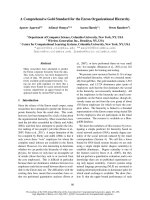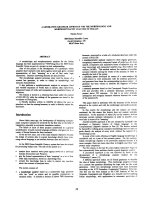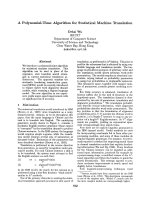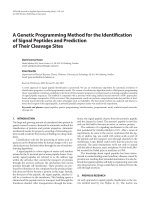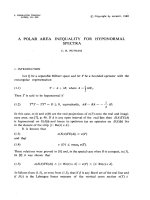Báo cáo toán học: " A Specht Module Analog for the Rook Monoid" pot
Bạn đang xem bản rút gọn của tài liệu. Xem và tải ngay bản đầy đủ của tài liệu tại đây (106.17 KB, 10 trang )
A Specht Module Analog for the Rook Monoid
Cheryl Grood
∗
Department of Mathematics and Statistics
Swarthmore College, Swarthmore, PA, USA
Submitted: July 20, 2001; Accepted: December 18, 2001.
MR Subject Classifications: 05E10, 20M30
Abstract
The wealth of beautiful combinatorics that arise in the representation theory of
the symmetric group is well-known. In this paper, we analyze the representations of
a related algebraic structure called the rook monoid from a combinatorial angle. In
particular, we give a combinatorial construction of the irreducible representations
of the rook monoid. Since the rook monoid contains the symmetric group, it is
perhaps not surprising that the construction outlined in this paper is very similar to
the classic combinatorial construction of the irreducible S
n
-representations: namely,
the Specht modules.
1 Introduction
Let R
n
be the set of all n×n matrices that contain at most one entry of one in each column
and row and zeroes elsewhere. Under matrix multiplication, R
n
has the structure of a
monoid, a set with an associative binary operation and an identity element. The monoid
R
n
is known both as the symmetric inverse semigroup and the rook monoid, the latter
name stemming from the correspondence between the matrices in R
n
and the placement
of non-attacking rooks on an n × n chessboard. The number of rank r matrices in R
n
is
n
r
2
r! and hence the rook monoid has a total of
n
r=0
n
r
2
r! elements. Note that the
set of rank n matrices in the rook monoid is isomorphic to S
n
, the symmetric group on n
letters.
It is often useful to associate each n × n matrix (a
ij
) ∈ R
n
with a function σ,givenby
σ(j)=
i if there exists an i such that a
ij
=1
0 otherwise.
∗
The author wishes to thank Stephen Maurer for reading an earlier draft of this paper and giving
many useful suggestions. The author is also grateful to Lou Solomon for encouraging her to write up
these results and to the referee for several helpful comments.
the electronic journal of combinatorics 9 (2002), #R2 1
This function is well-defined because at most one element in each column is nonzero. For
example, with n = 4 the matrix
0000
0010
1000
0001
corresponds to a map σ that sends 1 to 3, 2 to 0, 3 to 2, and 4 to 4. Note that when (a
ij
)
is a permutation matrix, the function σ is in fact the permutation associated with that
matrix. Munn [2] introduced a concise way of representing elements of R
n
using what he
termed cycle-link notation. In this notation, a cycle (a
1
,a
2
, ,a
k
) means, as in the case
of permutations, that
a
1
→ a
2
→ · · · → a
k
→ a
1
.
In contrast, a link [b
1
,b
2
, b
l
]meansthatb
1
→ b
2
→···b
l
and b
l
maps to 0. The 4 × 4
matrix above would translate to [1, 3, 2](4) in cycle-link notation.
Munn’s results ([2], [3]) on the representations of rook monoids stemmed from his
work on the more general theory of representations of finite semigroups. The representa-
tion theory of the rook monoid is particularly interesting because of its similarity to the
representation theory of the symmetric group. Munn showed that the complex monoid
algebra
R
n
is semisimple and subsequently found the irreducible representations of R
n
.
He demonstrated that these irreducibles are indexed by partitions of nonnegative inte-
gers less than or equal to n, whereas the irreducible representations of S
n
are indexed by
partitions of n. In addition, Munn computed the characters of the R
n
-irreducibles using
irreducible characters of S
r
, 1 ≤ r ≤ n.
More recently, Solomon ([5], [6]) has investigated q-generalizations of the rook monoid
as well as an analog of Schur-Weyl duality for R
n
, and Halverson et al.[1] have found
an R
n
analog of the Murnaghan-Nakayama rule, a combinatorial construction of the
irreducible characters of S
n
. In this paper, we provide a combinatorial construction for
the irreducible representations of R
n
that is very similar to the Specht module construction
of the irreducible representations of S
n
. Our construction and notation closely follow the
exposition in [4] on Specht modules.
2 Preliminaries
A partition is a finite sequence of nonnegative integers λ =(λ
1
,λ
2
, ,λ
m
) arranged in
a weakly decreasing order; that is, λ
1
≥ λ
2
≥ ≥ λ
m
≥ 0. The λ
i
are called the parts
of the partition. The weight of λ, denoted |λ|, is the sum of its parts: |λ| =
m
i=1
λ
i
.If
|λ| = r, we write: λ r. The partition with all parts equal to 0 is the empty partition.
The length of λ, denoted (λ), is the maximum subscript j such that λ
j
> 0. Associated
to each partition λ is a Ferrers diagram of shape λ. The Ferrers diagram has λ
i
boxes in
its i-th row, and the boxes are left-justified. For example, the Ferrers diagram associated
with λ =(6, 4, 3, 2, 2, 1) is
the electronic journal of combinatorics 9 (2002), #R2 2
The Ferrers diagram for the empty partition is denoted by ∅.Ifλ r,wesaythata
tableau of shape λ,oraλ-tableau, is a Ferrers diagram of shape λ with the boxes filled
with distinct entries from the set {1, 2, ,r}. The following is an example of a tableau
of shape (4, 2, 1, 1).
1348
26
5
7
Tableaux are at the core of the Specht module construction for the irreducibles of S
n
.
We now introduce a new object which will serve the same function for R
n
as the tableaux
did for S
n
.
Definition 2.1 Let λ r, where 0 ≤ r ≤ n.Ann-tableau of shape λ, also called a
λ
n
r
-tableau, is a Ferrers diagram of shape λ filled with r distinct entries from the set
{1, 2, ,n}.
For instance,
15
37
4
is an n-tableau of shape (2, 2, 1) for any n ≥ 7. Note that in the case where r = n,an
n-tableau of shape λ is in fact a tableau of shape λ.Thecontent of an λ
n
r
-tableau t is
the set of entries in t.Ann-tableau t of shape λ is standard if the entries in its rows and
columns increase left-to-right and top-to-bottom, respectively.
Notation 2.1 Let t be a λ
n
r
-tableau. Then t
i,j
will denote the entry contained in the box
of the ith row and jth column of t.
the electronic journal of combinatorics 9 (2002), #R2 3
Two n-tableaux t
1
and t
2
of shape λ are row-equivalent if the corresponding rows of the
two tableaux contain the same entries; in this case, we write t
1
∼ t
2
.
Definition 2.2 An n-tabloid {t} of shape λ,oranλ
n
r
-tabloid {t},isthesetofallλ
n
r
-
tableaux that are row-equivalent to t; i.e.,
{t} = {s | s ∼ t}.
Let N
λ
be the vector space over generated by the λ
n
r
-tableaux; that is, N
λ
is the set
of all formal
-linear combinations of λ
n
r
-tableaux. We can define an action of R
n
on N
λ
by first determining how R
n
acts on the basis of λ
n
r
-tableaux and then linearly extending
this action to the whole vector space. If t is an λ
n
r
-tableau, we define σt to equal the
zero vector if t contains an entry t
i,j
such that σ(t
i,j
)=0;whent contains no such entry,
we say that (σt)
i,j
= σ(t
i,j
). Similarly, if we let M
λ
represent the vector space over
generated by the λ
n
r
-tabloids, we have an induced action of R
n
on M
λ
given by:
σ{t} =
0 if σt = 0
{σt} otherwise.
Since s ∼ t implies that σs ∼ σt, this induced action is well-defined.
Suppose that t is an λ
n
r
-tableau, and let C
i
be the entries in the ith column of t.We
now form the group
C
t
= S
C
1
× S
C
2
×···×S
C
l
,
which we can think of as being contained in R
n
. Each element in C
t
stabilizes the columns
of t, but note that C
t
does not consist of all the elements in R
n
that fix the columns of t.
For each λ
n
r
-tableau t, we will generate the following element of M
λ
:
e
t
=
σ∈C
t
sgn(σ)σ{t},
where sgn stands for the sign of the permutation σ. We will call e
t
the n-polytabloid
associated with t.LetR
λ
be the vector space over generated by the set of n-polytabloids
of shape λ;letS
λ
be the subspace of R
λ
generated by {e
t
| t, λ
n
r
−tableau; content t =
{1, 2, ,r}}. The subspaces S
λ
, λ r, are exactly the so-called Specht modules,a
complete set of distinct irreducible S
r
-modules. We will show that the vector spaces R
λ
form a complete set of distinct irreducible R
n
-modules, and hence are analogous to the
Specht modules for the symmetric group.
3 R
n
-modules
The goal of this section is to show that for each λ such that |λ|≤n, R
λ
is an R
n
-module.
For that, we will need some new notation and several lemmas.
Definition 3.1 Let π ∈ R
n
. Then π will denote the element in S
n
that comes from
changing all the links in π to cycles.
the electronic journal of combinatorics 9 (2002), #R2 4
For example, if π =[1, 4, 6](2, 3)[5], then π =(1, 4, 6)(2, 3)(5). If π ∈ S
n
, then clearly
π = π.
Lemma 3.1 Suppose π ∈ R
n
and t is a λ
n
r
-tableau. If πt = 0, then πt = πt.
Proof. Express π in cycle-link notation. Since πt = 0, none of the entries t
i,j
occur
as a right-most element of a link of π.Thusπ(t
i,j
)=π(t
i,j
) for all i, j and so πt = πt. ✷
Lemma 3.2 If σ ∈ S
n
and t is an λ
n
r
-tableau with column entries C
1
, ,C
l
, then C
σt
=
σC
t
σ
−1
.
Proof. Let π =(i
1
,i
2
, ,i
j
)(i
j+1
, ,i
k
) ···(i
m
, ,i
n
) be an element in S
n
ex-
pressed in cycle notation. Now consider σC
t
σ
−1
.IfweviewC
t
as a subgroup of S
n
,it
follows that σC
t
σ
−1
= σS
C
1
σ
−1
×···×σS
C
l
σ
−1
. Because
σπσ
−1
=(σ(i
1
),σ(i
2
), ,σ(i
j
))(σ(i
j+1
), ,σ(i
k
)) ···(σ(i
m
), ,σ(i
n
)),
it follows that σS
C
i
σ
−1
= S
σ(C
i
)
,whereσ(C
i
) represents the set of elements {σ(j) | j ∈
C
i
}.So,
σC
t
σ
−1
= S
σ(C
1
)
×···×S
σ(C
l
)
,
which is exactly C
σt
. ✷
These lemmas allow us to prove the following proposition.
Proposition 3.3 Suppose π ∈ R
n
,t is a λ
n
r
-tableau. If πt = 0, then πe
t
= 0. Otherwise,
πe
t
= e
πt
.
Proof. First consider the case where πt = 0. Recall that πt = 0 if and only if
π{t} = 0 as well. Each term in the linear combination of tabloids that form e
t
contains
the exact same entries as t. Therefore, if π{t} = 0,thenπ{s} = 0 for all {s} in the linear
combination e
t
; it follows that in this case, πe
t
= 0.
If πt = 0,wehaveπt = πt by Lemma 3.1. Thus, π{s} = π{s} for every tabloid {s}
that appears in the linear combination e
t
, and hence πe
t
= πe
t
. By manipulating the
terms of πe
t
, we can conclude that
πe
t
= πe
t
= π
σ∈C
t
sgn(σ)σ{t}
=
σ∈C
t
sgn(σ)πσ{t}
=
σ∈C
t
sgn(πσπ
−1
)πσπ
−1
π{t}
=
σ∈C
t
sgn(πσπ
−1
)πσπ
−1
{ πt}
the electronic journal of combinatorics 9 (2002), #R2 5
=
γ∈πC
t
π
−1
sgn(γ)γ{πt}
=
γ∈C
πt
sgn(γ)γ{πt} (by Lemma 3.2)
= e
πt
.
✷
Thus, by Proposition 3.3, it follows that for any π ∈ R
n
and e
t
in R
λ
, πe
t
equals either
0 or e
πt
, both of which are again elements of R
λ
. This immediately gives us the following
corollary.
Corollary 3.4 R
λ
is an R
n
-module.
Furthermore, we are able to show easily that
Corollary 3.5 R
λ
is a cyclic R
n
-module.
Proof. Note that if s and t are both λ
n
r
-tableaux, there exists an element σ in S
n
such that s = σt. By Proposition 3.3, we have that σe
t
= e
σt
.Sinceσ ∈ S
n
,σ = σ,and
so σe
t
= e
σt
, which in turn equals e
s
. Since we can generate all the basis elements of R
λ
using one element e
t
, R
λ
is cyclic. ✷
4 Irreducibility of R
λ
Let |λ| = r,withr ≤ n. Recall that the subspace S
λ
of R
λ
is an irreducible S
r
-module.
We will use this fact to help show that R
λ
is an irreducible R
n
-module.
Theorem 4.1 If |λ|≤n, R
λ
is an irreducible R
n
-module.
Proof. Let U be a nonzero submodule of R
λ
. We need to show that U must in fact be
equal to R
λ
.SinceR
λ
is a cyclic module, it suffices to show that we can find a λ
n
r
-tableau
t such that e
t
∈ U.
Let u beanonzeroelementofU,andwriteu as a linear combination of n-polytabloids:
u =
t,
λ
n
r
-tableau
a
t
e
t
.
We now group the tabloids based on their content; i.e.,
u =
X ⊂{1, ,n}
|X| = r
t,
tableau of content X
a
t
e
t
.
the electronic journal of combinatorics 9 (2002), #R2 6
Since u = 0, there must be at least one set X
0
such that
t,
content t = X
0
a
t
e
t
= 0.
If X
0
= {i
1
,i
2
, ,i
r
},wherei
1
<i
2
< < i
r
, consider the element π in R
n
defined by
π(k)=
0ifk ∈ X
0
j if k = i
j
.
Note that we have defined π in such a way so that πt = 0 if and only if content t = X
0
.
Multiplying u by π,weobtain
πu =
t,
λ
n
r
-tableau
a
t
(πe
t
).
By Proposition 3.3, if πt = 0,thenπe
t
= 0. We have defined π in such a way that all the
terms in πu with content not equal to X
0
vanish. Thus, πu simplifies to
πu =
t,
content t = X
0
a
t
(πe
t
),
which in turn equals
t,
content t = X
0
a
t
(πe
t
), since both π and π act the same on tabloids
of content X
0
. Multiplying on the left by π
−1
,weseethat
u = π
−1
(πu)
=
t,
content t = X
0
a
t
π
−1
(πe
t
)
=
t,
content t = X
0
a
t
e
t
, (1)
which is nonzero, so πu cannot be 0.
Now we apply Proposition 3.3 to (1), so that
πu =
t,
content t = X
0
a
t
e
πt
.
Now observe that when the content of t is X
0
, the content of πt equals {1, 2, ,r},which
in turn implies that e
πt
∈ S
λ
.Sinceπu is a linear combination of elements in S
λ
, πu itself
is an element of S
λ
. Hence U ∩S
λ
= 0, since the intersection contains the nonzero element
πu. Viewing U as an S
r
-module (by realizing S
r
⊂ R
n
), we have that U ∩S
λ
is a nonzero
S
r
-submodule of S
λ
. By the irreducibility of S
λ
, we can conclude that U ∩ S
λ
= S
λ
and
thus S
λ
⊆ U.Nowpickanye
t
∈ S
λ
; e
t
must also be contained in U, and since R
λ
is
cyclic,wehavethatU = R
λ
as desired. ✷
Now that we know that these modules are irreducible, we need to show that they are
all distinct.
the electronic journal of combinatorics 9 (2002), #R2 7
Theorem 4.2 If R
λ
and R
µ
are isomorphic as R
n
-modules, then λ = µ.
Proof. Let Θ : R
λ
−→ R
µ
be an R
n
-isomorphism. Let t be a λ
n
r
-tableau. The image
of e
t
under Θ is a linear combination of {e
s
| s, standard µ
n
r
− tableaux}. If the entry i is
in t,thenπ = (1)(2) ···
(i) ···(n)[i] annihilates t, and hence e
t
as well. Thus, Θ(πe
t
)=0,
which implies that
0 = πΘ(e
t
)
= π
s,
standard µ
n
r
− tableau
a
s
e
s
=
s,
standard µ
n
r
− tableau
a
s
πe
s
=
s,
standard µ
n
r
− tableau
πs = 0
a
s
e
πs
(by Proposition 3.3)
=
s,
standard µ
n
r
− tableau
πs = 0
a
s
e
s
,
since π is the identity element. The only linear combination of basis elements that equals 0
is the trivial one; thus, Θ(e
t
) is a linear combination of {e
s
| s, standard µ
n
r
−tableau, πs =
0}. However, the only tableaux that π annihilates are those that contain an entry of i.
Since this argument holds for every i in the content of t,Θ(e
t
) is a linear combination of
µ
n
r
-polytabloids e
s
such that the content of t is a subset of the content of s.SinceΘis
invertible, we in fact have that
Θ(e
t
)=
s,
standard µ
n
r
− tableau
content
s = content t
a
s
e
s
. (2)
Recall that S
λ
is the subspace of R
λ
generated by the polytabloids with content 1, 2, ,|λ| .
It follows from Equation 2 that the image of S
λ
under Θ is contained in S
µ
;thatis,S
λ
is
isomorphic to a submodule of S
µ
.Theonlywaythiscanoccurisifλ = µ,whichiswhat
we wanted to show. ✷
5 A Basis for R
λ
In closing, we give a combinatorial basis for our irreducible R
n
-modules R
λ
. Again, the
story closely resembles what happens in the case of the irreducible S
r
-modules S
λ
.Inthat
case, a basis for S
λ
consists of {e
t
| t is a standard tableau of shape λ}. We will establish
that a similar statement holds for R
λ
:
the electronic journal of combinatorics 9 (2002), #R2 8
Theorem 5.1 Let λ r, with 0 ≤ r ≤ n. Then the set
{e
t
| t is a standard λ
n
r
-tableau}
is a basis for R
λ
.
Proof. First, we will show that the e
t
are linearly independent. If the content of two
λ
n
r
-tableaux s and t differ, it is not hard to see that e
t
and e
s
are independent. Therefore,
it suffices to show that
{e
t
| t, standard λ
n
r
-tableau with content X}
is independent. Without loss of generality, assume that the content X is the set {1, 2, ,r}.
Since these polytabloids form a basis for S
λ
, they are independent, which is what we
wanted to show.
Next, we compute the order of {e
t
| t is a standard λ
n
r
-tableau}.Thereare
n
r
ways
to choose a fixed content X.Letf
λ
denote the number of standard tableaux of shape λ.
Then in fact f
λ
counts the number of λ
n
r
-tableaux with a given content X. Hence, the
set {e
t
| t is a standard λ
n
r
-tableau} has
n
r
f
λ
elements. Since we have shown that these
vectors are independent, we can conclude that the dimension of R
λ
is at least
n
r
f
λ
.
For semisimple algebras, the sum of the squares of the dimensions of its nonisomorphic
irreducible modules equals the dimension of the algebra itself; i.e.,
I,
irreducible A − module
(dim I)
2
=dimA.
Suppose there is some λ such that the dimension of R
λ
is strictly larger than
n
r
f
λ
. Then
we would have
n
r=0
n
r
2
r!=dim R
n
<
n
r=0
λr
(dim R
λ
)
2
=
n
r=0
λr
n
r
2
(f
λ
)
2
=
n
r=0
n
r
2
(
λr
(f
λ
)
2
).
But, it is a well-known combinatorial identity that
λr
(f
λ
)
2
= r!
(cf. [4]), and so every irreducible module R
λ
must have dimension equal to
n
r
f
λ
. Hence,
the set of independent vectors {e
t
| t is a standard λ
n
r
-tableau} also spans R
λ
.Thuswe
have shown that {e
t
| t is a standard λ
n
r
-tableau} is a basis for R
λ
. ✷
the electronic journal of combinatorics 9 (2002), #R2 9
References
[1] M. Dieng, T. Halverson, and V. Poladian, Characters of the q-rook monoid, preprint,
2001.
[2] W.D. Munn, Matrix representations of semigroups, Proc. Camb. Phil. Soc., 53
(1957), 5-12.
[3] W.D. Munn, The characters of the symmetric inverse semigroup, Proc. Camb. Phil.
Soc., 53 (1957), 13-18.
[4] B. Sagan, The Symmetric Group, Wadsworth and Brooks Cole, Pacific Grove, CA,
1991.
[5] L. Solomon, Representations of the Rook Monoid, to appear in J. Algebra.
[6] L. Solomon, Representations of the Symmetric Inverse Semigroup, Address given at
C.R.M. Montr´eal, 1997.
the electronic journal of combinatorics 9 (2002), #R2 10


